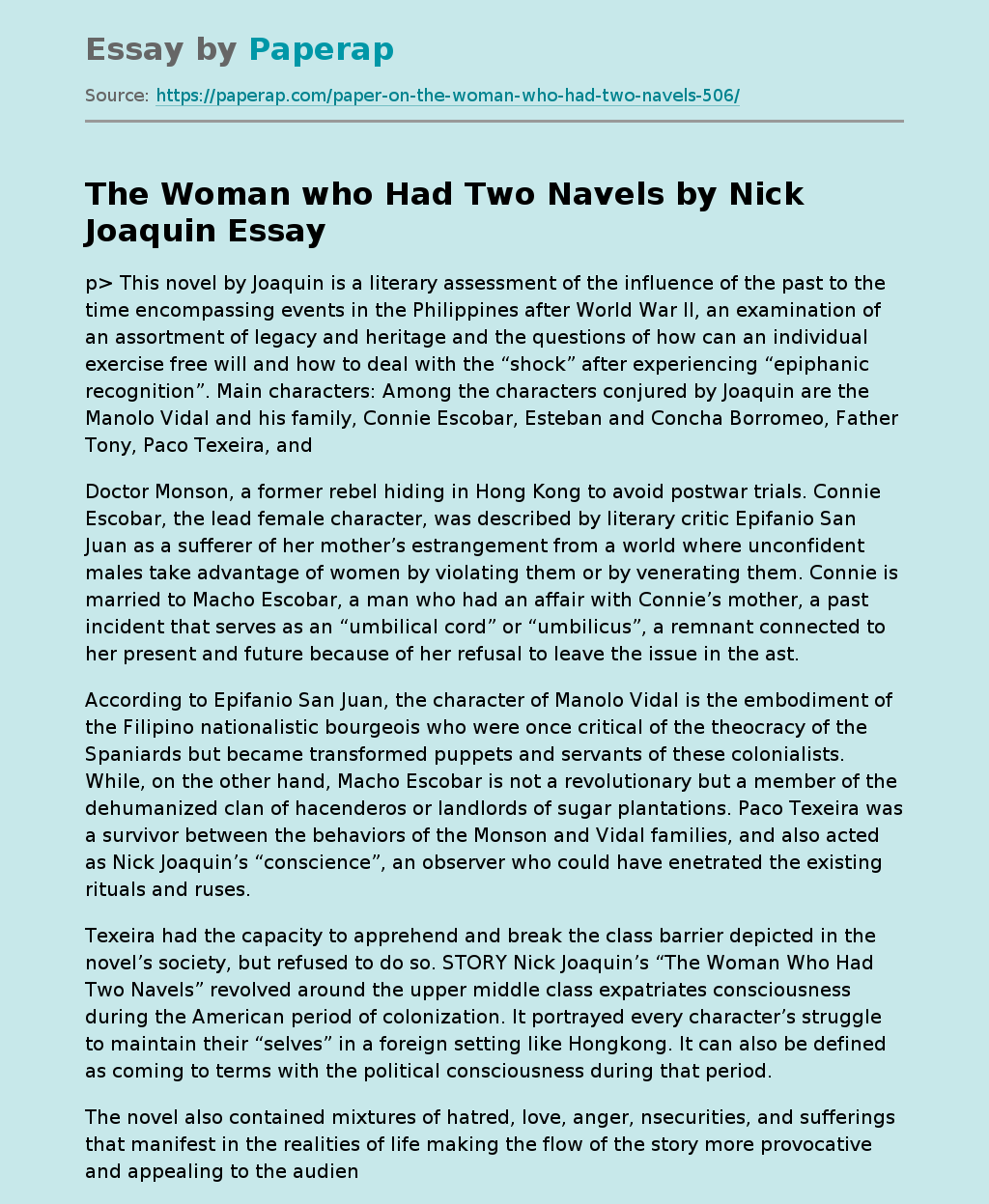The Woman who Had Two Navels by Nick Joaquin
p> This novel by Joaquin is a literary assessment of the influence of the past to the time encompassing events in the Philippines after World War II, an examination of an assortment of legacy and heritage and the questions of how can an individual exercise free will and how to deal with the “shock” after experiencing “epiphanic recognition”. Main characters: Among the characters conjured by Joaquin are the Manolo Vidal and his family, Connie Escobar, Esteban and Concha Borromeo, Father Tony, Paco Texeira, and
Doctor Monson, a former rebel hiding in Hong Kong to avoid postwar trials.
Connie Escobar, the lead female character, was described by literary critic Epifanio San Juan as a sufferer of her mother’s estrangement from a world where unconfident males take advantage of women by violating them or by venerating them. Connie is married to Macho Escobar, a man who had an affair with Connie’s mother, a past incident that serves as an “umbilical cord” or “umbilicus”, a remnant connected to her present and future because of her refusal to leave the issue in the ast.
According to Epifanio San Juan, the character of Manolo Vidal is the embodiment of the Filipino nationalistic bourgeois who were once critical of the theocracy of the Spaniards but became transformed puppets and servants of these colonialists. While, on the other hand, Macho Escobar is not a revolutionary but a member of the dehumanized clan of hacenderos or landlords of sugar plantations. Paco Texeira was a survivor between the behaviors of the Monson and Vidal families, and also acted as Nick Joaquin’s “conscience”, an observer who could have enetrated the existing rituals and ruses.
Texeira had the capacity to apprehend and break the class barrier depicted in the novel’s society, but refused to do so. STORY Nick Joaquin’s “The Woman Who Had Two Navels” revolved around the upper middle class expatriates consciousness during the American period of colonization. It portrayed every character’s struggle to maintain their “selves” in a foreign setting like Hongkong. It can also be defined as coming to terms with the political consciousness during that period.
The novel also contained mixtures of hatred, love, anger, nsecurities, and sufferings that manifest in the realities of life making the flow of the story more provocative and appealing to the audience. The title of the novel excited my curiosity; that’s why it took me a long time to analyze and think the interpretations that I have to use to show its significance. The story started with Connie, a daughter of a wealthy politician. Connie portrayed herself as a person with two navels. Literally, when a woman has two navels, this means that she has two umbilical cords.
The navel is the shortened umbilical cord – usually removed when a person is orn. But it is not possible because if a person has two umbilical cords, he is a preternatural being – a mutant. Connie, pretending that she has two navels may refer to the “rebirths” that she underwent. The first rebirth was escaping from her mother’s evil clutches since she was an unwanted child – always ostracized and continously suffered from the ghosts of the past that haunted her. Let us not also affair of her husband Macho and her mother that made her feel miserable at some points in her life.
The second rebirth refers to her awakening, her self realization and mancipation as a woman. She learned to face reality and accepted the truth. In my point of view, her reason why she pretended to have two navels is that she wanted to forget everything about her, to be different so that another personality will reside and dwell on her. Looking from another perspective, in this case coming from a historical vantage point, the two navels may signify Hongkong and the Philippines. Even if the story was set in Hongkong, still, Filipino culture is present in its context.
Furthermore as the novel progressed, it presented the Filipinos need to bond ogether and attempted to reestablish their roots; however musch as when they, as exemplified by Paco, were made unaware of the Filipino culture. The novel also portrayed an interlocution between Chinese and Filipino consciousness. An example of this was Rita who “dresses up in dragons and pagan Jewels to meditate on the Virgin. ” The sense of nationalism and being Filipino was depicted in Connie’s character that made her symbolize the country. The fact that she was born in Hongkong, she still longed for her native land – the Philippines.
And like most of us Filipinos, she tried to laugh at every problem and pretended that everythings fine. This trait refuted the positive notion of being Filipino. In relation to the stories title, a lot of Connies exist in our present realm. Up to this time, it is obvious that some of our mother-daughter relationships fail. As individuals, we are afraid to admit the truth within ourselves. We usually deny the mistakes that we commit. We try to live a world of lies. We want to escape from our realities and always make excuses.
Let us not forget that even if it is painful to face the truth, this will gradually help us in ccepting ourselves more and be better persons. Though we may encounter some unexpected instances, the fact that we resign ourselves to certainty and veracuty is more than enough. Joaquin presented the novel without the consistency of a normal narrative – presenting the story in a non-linear manner and focused first on the present and unfolded the numerous settings as every character was introduced on several parts. It revolved around the concern of the “little people and of the metanarratives that were expounded on as the story was completed.
The Woman who Had Two Navels by Nick Joaquin. (2018, Apr 27). Retrieved from https://paperap.com/paper-on-the-woman-who-had-two-navels-506/

